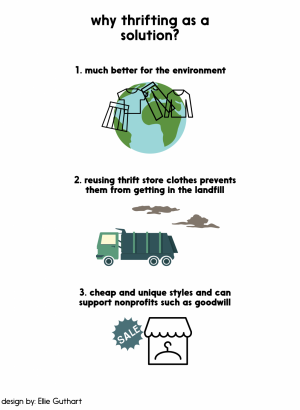Fast Fashion Equals Fast Waste
The process of fast fashion has been increasing throughout the world and impacting the earth’s environment.
The shirt you got from Forever 21 and your brand new pair of jeans you got for a bargain at H&M. Those stores and many others are fast fashion brands. Fast fashion is when a fashion brand sells trendy clothing inexpensively to customers produced rapidly by mass-market retailers. The whole process takes about five weeks to design, manufacture and sell, much faster than it used to be and is increasing throughout the world, especially in developed countries.
Since the late 1990s, the demand for clothing increased as manufacturing developed. Fast fashion became more popular as customers found a benefit: trendy clothing at an affordable price. These two factors were the key to success in fast fashion. Those two factors cause customers to be part of a repetitive cycle of buy, wear, and throw. Today many customers find the need to constantly own trendy clothing, and fast fashion is what they turn to because of its convenience.
Although there are benefits of fast fashion, the drawbacks outweigh the benefits. Fast fashion produces a massive amount of clothing in a short period of time and they are put out into stores at a rapid pace. The clothing in the store doesn’t always end up into a customer’s closet, instead, they go to the landfills. Destroying unsold clothing is a characteristic of fast fashion, causing it to be the second largest polluter after oil. The massive amount of clothing may keep the customers satisfied, but leads to a countless amount of clothing items going into landfills.
In fact in 2012, 84% of the United States’ unwanted clothing ended up in a landfill. The landfills are continuing to grow and they are taking over the earth’s land that could be used for a more productive purpose, such as food production or housing. Unlike food, clothing that is made out of non-natural material cannot biodegrade. Cotton, silk, and other clothing materials are buried in the landfills and producing methane and carbon dioxide. Carbon dioxide emissions are one of many biggest problems that come from fast fashion and the main contributor to climate change. The carbon dioxide doesn’t just come out of buried clothing but during the process of fast fashion as well. Fashion industries are responsible for 10% of worldwide carbon dioxide emissions. Transportation, production, and manufacturing all use energy to create the majority of the greenhouse gases.
Some entrepreneurs are making a move to make fast fashion more eco-friendly. For example, H&M has set a wardrobe recycling program to avoid having customers to just throw away their clothing. The customers who bring in five or more clothing items or shoes will receive a discount. A strategy that Patagonia has been doing is to make their fleece jackets out of polyester from recycled bottles. Certainly there are many other entrepreneurs that are doing the same thing, but those are not the only solution to this problem. Customers can also take part in this solution by recycling, reusing their unwanted clothing, and shopping at thrift stores.











